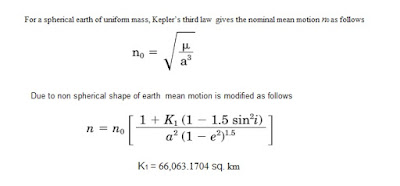Perturbation is the complex motion of a massive body subject to forces other than the gravitational attraction of a single other massive body.
Orbital perturbation is the difference between real orbit and Keplerian orbit obtained from two body equations of motion.
An orbit described by Kepler is ideal as Earth is considered to be a perfect sphere and the force acting around the Earth is the centrifugal force. This force is supposed to balance the gravitational pull of the earth.
In reality, other forces also play an important role and affect the motion of the satellite. These forces are the gravitational forces of Sun and Moon along with the atmospheric drag.
Effect of Sun and Moon is more pronounced on geostationary earth satellites where as the atmospheric drag effect is more pronounced for low earth orbit satellites.
Effects of non-Spherical Earth
As the shape of Earth is not a perfect sphere (oblate spheroid), it causes some variations in the path followed by the satellites around the primary. As the Earth is bulging from the equatorial belt, and keeping in mind that an orbit is not a physical entity, and it is the forces resulting from an oblate Earth which act on the satellite produce a change in the orbital parameters.
This causes the satellite to drift as a result of regression of the nodes and the latitude of the point of perigee. This leads to rotation of the line of apsides. As the orbit itself is moving with respect to the Earth, the resultant changes are seen in the values of argument of perigee and right ascension of ascending node.
Due to the non-spherical shape of Earth, one more effect called as the “Satellite Graveyard” is seen. The non-spherical shape leads to the small value of eccentricity at the equatorial plane. This causes a gravity gradient on GEO satellite and makes them drift to one of the two stable points
Atmospheric Drag
For near-earth satellites (below about 1000 km) the effects of atmospheric drag are significant. Because the drag is greatest at the perigee, the drag acts to reduce the velocity at this point, with the result that the satellite does not reach the same apogee height on successive revolutions.The result is that the semi major axis and the eccentricity are both reduced.
Read About : ORBITAL EFFECTS ON SATELLITES PERFORMANCE


No comments:
Post a Comment